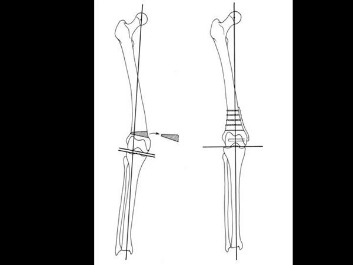Distal Femoral Osteotomy Seattle, Wa
Several authors have identified a postoperative HKA of 3–5° valgus or a mechanical axis at 62–sixty six% of the tibial width as optimum in medial OA . Recently studies think about the extent of medial chondromalacia and carry out an individually adjusted correction with a extra moderate targeted vary of valgus (HKA 1.7–5° or 50–65% of the total tibial plateau width), while avoiding overcorrection . A knee joint arthroscopy is really helpful in the same session, for addressing intraoperative pathologies and fantastic-tuning of correction, relying on the kind and extent of intraarticular injury .

Through applicable indication and affected person choice, both kinds of valgisation osteotomies near the knee joint can provide improvements in medical function, ache stage and high quality of life. These joint-preserving interventions thus represent a useful treatment choice in varus deformities. Varus deformities of the knee are frequently corrected by osteotomies, which must be performed on the degree of origin. But in distinction to high tibial osteotomies , little knowledge exists for distal femoral osteotomies . An Osteotomy is a managed surgical break or fracture of the bone to allow realignment of the limb.
Femoral Distal Opening And Shutting Wedge Osteotomy :
Diagnostic arthroscopy can be utilized to assess for related meniscoligamentous or cartilage injuries for concomitant procedures with the osteotomy. The denoted constructions represent the lateral femoral condyle , the lateral meniscus , and the lateral tibial plateau . The aim of surgery is to re-create neutral alignment, such that the mechanical axis line passes through the center of the knee.3 The amount of correction is calculated primarily based on the angle fashioned between the mechanical axis of the femur and tibia . Practically, 5 degrees of malalignment is the edge to contemplate osteotomy.
- The method introduced on this article offers a protected, reproducible technique to perform the medial closing-wedge DFO.
- Corticocancellous wedges are harvested from the femoral neck portion of an allograft femoral head and placed into the osteotomy site according to the preoperative plan.
- Among them, Salter-Harris sort II is the commonest, making up about half of development plate fractures, whereas types IV and V are rare, accounting for just a few p.c .
- The diaphyseal midline was marked with an electrocautery and a Codman pen to avoid angular deviation in the course of the stabilization of the plaque.
Sports-related injuries and motorcar accidents are presently the commonest causes of injury. Proper care of these injuries includes counseling sufferers and fogeys concerning the long run probability of progress-associated problems. Among them, Salter-Harris sort II is the most common, making up about half of development plate fractures, whereas varieties IV and V are uncommon, accounting for only some p.c . Distal femoral perichondral ring harm (SH sort VI, Rang’s kind VI) is a comparatively uncommon harm and is known to lead to a excessive prevalence of progress disorders with angular deformity . However, the timing of therapy and approaches to therapy have but to be established.